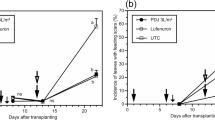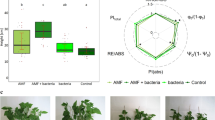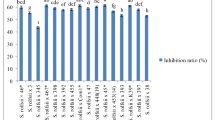Abstract
In this study, the hypothesis was tested that removal of substrate for sporulation ofBotrytis spp. may lead to a retardation of an epidemic if the majority of the inoculum is produced inside the treated crop. Suppression of sporulation ofBotrytis spp. could be an attractive option for biological control ofBotrytis leaf spot in onions. In a field experiment, necrotic leaf tissue was removed to simulate the effect of a biocontrol agent. By this means, the amount of substrate on whichBotrytis spp. sporulates was reduced. In the experiment, the spore load above the onion plots was significantly reduced and the epidemic of onion leaf spot was retarded. At the end of the growing season, the number of leaf lesions in the green leaf area was lower in plots with substrate removal than in control plots (0.6 and 1.1 cm−2, respectively). The results demonstrated that an epidemic of onion leaf spot largely depends on the rate of inoculum production inside a crop. Thus, suppression of sporulation on necrotic leaf tissue is a valid control strategy that could be applied by using sporulation suppressing antagonists.
Similar content being viewed by others
References
Adee EA and Pfender WF (1989) The effect of primary inoculum level ofPyrenophora tritici-repentis on tan spot epidemic development in wheat. Phytopathology 79: 873–877
Aylor DE (1993) Relative collection efficiency of Rotorod and Burkhard spore samplers for airborneVenturia inaequalis ascospores. Phytopathology 83: 1116–1119
Braun PG and Sutton JC (1986) Management of strawberry grey mould with fungicides targeted against inoculum in crop residues. Proceedings of the British Crop Protection Conference-Pests and Diseases, pp 915–921
Braun PG and Sutton JC (1987) Inoculum sources ofBotrytis cinerea in fruit rot of strawberries in Ontario. Canadian Journal of Plant Pathology 9: 1–5
Braun PG and Sutton JC (1988) Infection cycles and population dynamics ofBotrytis cinerea in strawberry leaves. Canadian Journal of Plant Pathology 10: 133–141
Dubos B (1987) Fungal antagonism in aerial agrobiocenoses. pp 107–135 in Chet I (ed) Innovative Approaches to Plant Disease Control, J. Wiley and Sons, New York
Dubos B (1992) Biological control ofBotrytis: state of the art. pp 169–178 in Verhoeff K, Malathrakis, NE and Williamson B (eds) Recent Advances inBotrytis Research, Pudoc Scientific Publishers, Wageningen
Edmonds RL (1972) Collection efficiency of Rotorod samplers for sampling fungus spores in the atmosphere. Plant Disease Reporter 56: 704–708
Elad Y, Köhl J and Fokkema NJ (1994) Control of infection and sporulation ofBotrytis cinerea on bean and tomato by saprophytic yeasts. Phytopathology 84: 1193–1200
Elad Y, Zimand G, Zaqs Y, Zuriel S and Chet I (1993) Use ofTrichoderma harzianum in combination or alternation with fungicides to control cucumber grey mould (Botrytis cinerea) under commercial greenhouse conditions. Plant Pathology 42: 324–332
Ellerbrock LA and Lorbeer JW (1977) Sources of primary inoculum ofBotrytis squamosa. Phytopathology 67: 363–372
Ellis MB (1971) Dematiaceous hyphomycetes. Commonw Mycol Inst, Kew
Elmer PAG, Boyd-Wilson K, Cook D, Gaunt RE, Frampton C and Pyke N (1993) Sources ofBotrytis cinerea inoculum in kiwifruit orchards and the relationship between total inoculum potential, external fruit contamination and stem end rot of kiwifruit. Abstracts of the 6th International Congress of Plant Pathology, Montreal, Canada (p. 110)
Fokkema NJ (1993) Opportunities and problems of control of foliar pathogens with micro-organisms. Pesticide Science 37: 411–416
Fokkema NJ, Gerlagh M and Köhl J (1992) Biological control ofSclerotinia sclerotiorum andBotrytis spp., pp 267–271 in Tjamos EC, Papavizas G and Cook RJ (eds) Biological Control of Plant Diseases-Progress and Challenge for the Future (Proc. NATO Advanced Research Workshop), Plenum Press, New York
Genstat 5 Committee (1990). Genstat 5 Reference Manual. Payne RW (Chairman) and Lane PW (Secretary). Clarendon Press, Oxford
Gregory PH and Hirst JM (1957) The summer air-spora at Rothamsted in 1952. The Journal of General Microbiology 17: 135–152
Gullino ML (1992) Chemical control ofBotrytis spp., pp 217–222 in Verhoeff K, Malathrakis NE and Williamson B (eds) Recent Advances inBotrytis Research, Pudoc Scientific Publishers, Wageningen
Gullino ML and Garibaldi A (1988) Biological and integrated control of grey mould of grapevine: results in Italy. EPPO Bulletin 18: 9–12
Jarvis WR (1962a) The epidemiology ofBotrytis cinerea Pers. in strawberries. Proceedings 16th International Horticultural Congress Vol. III: 258–262
Jarvis WR (1962b) The infection of strawberry and raspberry fruits byBotrytis cinerea Fr. Annals of Applied Biology 50: 569–575
Jarvis WR (1962c) The dispersal of spores ofBotrytis cinerea Fr. in a rasberry plantation. Transactions of the British mycological Society 45: 549–559
Jordan VWL and Pappas AC (1977) Inoculum suppression and control of strawberryBotrytis. Proceedings British Crop Protection Conference—Pests and Diseases, pp 341–348
Köhl J and Fokkema NJ (1994) Fungal interactions on living and necrotic leaves, pp 321–334 in Blakeman JP and Williamson B (eds) Ecology of Plant Pathogens, CABI, Oxon, UK
Köhl J and Schlösser E (1989) Decay of sclerotia ofBotrytis cinerea byTrichoderma spp. at low temperatures. Journal of Phytopathology 125: 320–326
Köhl J, van der Plas CH, Molhoek WML and Fokkema NJ (1993) Drought tolerance as a major selection criterium for antagonists ofBotrytis spp., pp 169–172 in Fokkema NJ, Köhl J and Elad Y (eds) Biological Control of Foliar and Post-harvest Diseases, IOBC/WPRS Bulletin 16(11)
Maude RB (1980) Disease control, pp 275–308 in Coley-Smith JR, Verhoeff K and Jarvis WR (eds) The Biology ofBotrytis, Academic Press, London
Miller PM and Waggoner PE (1957) Dispersal of spores ofBotrytis cinerea among strawberries. Phytopathology 47: 24–25
Pfender WF, Zhang W and Nus A (1993) Biological control to reduce inoculum of the tan spot pathogenPyrenophora tritici-repentis in surface-borne residues of wheat fields. Phytopathology 83: 371–375
Plaut JL and Berger RD (1981) Infection rates in three pathosystem epidemics initiated with reduced disease severities. Phytopathology 71: 917–921
Sutton JC and Peng G (1993) Biocontrol ofBotrytis cinerea in strawberry leaves. Phytopathology 83: 615–621
Sutton JC and Peng G (1993) Manipulation and vectoring of biocontrol organisms to manage foliage and fruit diseases in cropping systems. Annual Review of Phytopathology 31: 473–493
Sutton JC, Swanton CJ and Gillespie TJ (1978) Relation of weather variables and host factors to incidence of airborne spores ofBotrytis squamosa. Canadian Journal of Botany 56: 2460–2469
Author information
Authors and Affiliations
Rights and permissions
About this article
Cite this article
Köhl, J., Molhoek, W.M.L., van der Plas, C.H. et al. Suppression of sporulation ofBotrytis spp. as a valid biocontrol strategy. Eur J Plant Pathol 101, 251–259 (1995). https://doi.org/10.1007/BF01874781
Accepted:
Issue Date:
DOI: https://doi.org/10.1007/BF01874781




